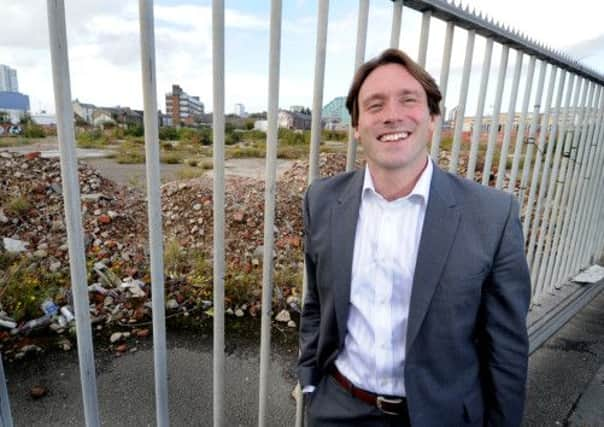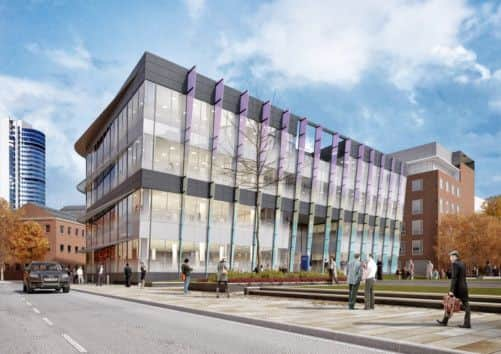Tale of two cities as stagnant developments rise from the rubble


At the dawn of the Millennium, the future couldn’t have seemed brighter for Leeds. Talked of as a financial centre in the same breath as London, the city’s skyline was changing at a pace. Alongside shiny new apartments to house the growing population of young professionals, countless glass-fronted office blocks took the place of wasteland as the centre expanded to meet the needs of business.
A symbol of Leeds’s ambition in 2007 was the landmark Lumiere project, which would have been the tallest residential development in western Europe. Driven by KW Linfoot, the blueprints promised much, but ultimately did not deliver its twin 54 and 32-storey glass skyscrapers.
Advertisement
Hide AdAdvertisement
Hide AdWhile plans were passed and construction began at the site, between Whitehall Road and Wellington Street, that December, by the summer of the following year it had stalled. KW Linfoot went into administration six months later and the site has stood vacant ever since.


It wasn’t the only development to fall victim to the crash. Leeds was left with a rash of half-finished, never-started projects, but after more than half a decade of stagnation, inner city brownfield sites seem to be finally back on the radar of ambitious developers.
Seven years without a significant new build city office development had passed when Leeds City Council planners approved proposals to create KPMG’s new 61,000 sq ft headquarters in Sovereign Street, Leeds, earlier this year.
The Sovereign Street site itself fell victim to the recession after a £115m scheme dubbed ‘The Kissing Towers’ was scrapped as the credit crunch struck. But with revised plans now in the pipeline, it is thought that the KPMG offices could be among the first wave of inner city builds after years of economic doom and gloom.
Advertisement
Hide AdAdvertisement
Hide AdDr Kevin Grady heads Leeds Civic Trust’s committee which monitors new planning applications concerning the Leeds metropolitan district and he often meets with developers before plans are formally submitted to the council.
He told the Yorkshire Post: “Certainly in the last six months or so we have seen a distinct pick up in activity, so there are schemes in the pipeline that are not yet in the public domain. We are encouraged by the fact that some of those that were in the pipeline before the recession are now coming back.
“Over the next six to 12 months there are going to be several more cranes in the city skyline than there have been in a long time.”
Dr Grady believes that confidence among developers is growing as the city embraces bold projects such as the Trinity Leeds shopping centre and the soon-to-open First Direct Arena.
Advertisement
Hide AdAdvertisement
Hide AdThe figures seem to back the notion that progress is being made, as builders are on site to construct a five-storey grade A office development for law firm Shulmans at 10 Wellington Place and a further six new-build office and mixed use sites have been approved by the council in recent months.
The number of comparable projects approved before the recession hit in 2006 was 10, although many of those sites still lay undeveloped.
Dr Grady said: “Over the past four or five years there have been feelings that confidence was coming back, but of course now confidence is coming back but in material ways – developers are prepared to start putting their money behind projects.
“Clearly there is still a major issue about finance but you don’t know when you have come out of recession until two years later and on the evidence of what we are seeing at the moment this is the most positive sign for several years.”
Advertisement
Hide AdAdvertisement
Hide AdHe warned that Leeds will not return to the “crazy boom days” where developments were being built “without much consideration as to whether it was commercially viable” but that the city has a great opportunity to move forward.
David Wells, development director at Muse Developments which is partly behind the Sovereign Street project, claims the recent mini surge in applications is a result of expanding businesses coinciding with expiring leases on existing offices.
“If people are looking around now for grade A space in the city centre there isn’t any available and the buildings built five or six years ago, they’re let,” he said. “If their requirement is to expand, the only way to strengthen that is through having new buildings built for them.”
He said KPMG’s move to the new under construction Sovereign Street site is 20 per cent larger than their current premises. And the assertion that businesses are reaching a turning point is backed by a 2013 report by industry experts Jones Lang LaSalles.
Advertisement
Hide AdAdvertisement
Hide AdIt states that leases covering around 1.1m sq ft of office space in Leeds will expire over the next two years, and that with a “lack of new smaller or medium sized buildings” it seems “likely” that more firms will seek to pre-let new build offices.
Positive signs of recovery aren’t just being seen north of the river however, as the former industrial brownfield sites south of Leeds bridge are facing renewed interest.
Plans for one of the largest free schools in the country, the Ruth Gorse Academy, were approved earlier this year, while a new Leeds City College campus will open in Hunslet Road in September.
David Lumb, from the Leeds Sustainable Trust which is partly behind the school plans, said: “You could say there is a renaissance starting in education down there, which is a very good way of starting a sustainable community for the south.”
Advertisement
Hide AdAdvertisement
Hide AdThe educational moves forward he hopes will be backed by residential and business developments, which he believes are now far more realistic as land values are at a more sensible level.
A £43m data centre run by telecoms firm AQL to be built at former Yorkshire Chemicals land by 2015 is a scheme, attracted by Leeds city centre south’s potential, that is aimed at attracting businesses with IT data needs to the city.
AQL’s founder and chief executive Dr Adam Beaumont believes that land valuations in the city are now “realistic”, which makes buying land and funding developments far easier and attractive.
The former University of Leeds lecturer said: “We are seeing applications by companies across different sectors to build and own the freehold of their business premises, which is a really good sign.”
Advertisement
Hide AdAdvertisement
Hide AdAnd even the Leeds project most synonymous with the financial crash is nearing development.
Late last year plans for two office buildings, one 11 storeys and the other eight storeys on the former Lumiere site, were submitted to Leeds City Council. They are still pending consideration.
The proposals for the 262,000 sq ft office development by consultancy firm EC Harris and architects Aedas would be called Central Square and primarily aim to provide “top quality Grade A office accommodation”.
Speaking when the planning application was submitted last year, Roger Thompson, development management partner at EC Harris, said: “The development plans for the site which have taken shape are the product of several months’ hard work and collaboration from an excellent team.
Advertisement
Hide AdAdvertisement
Hide Ad“The result is a design of a scale and quality commensurate with the importance of the site and the city. We look forward to continuing to work with Leeds City Council to ensure the application submitted is approved as soon as possible.”
Last year EC Harris were drafted in by Deloitte to make the mothballed Lumiere site more attractive to potential investors and occupiers and it may be a sign of good things to come.
A Leeds City Council spokeswoman added: “Demand for city centre office space is on the up and expected to outstrip the demand seen in 2012. This year is seeing a revival in the city centre office market with take up at a higher level than for many years.”